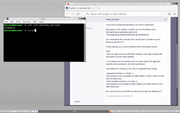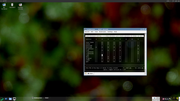You are not logged in.
- Topics: Active | Unanswered
#176 Re: Hardware & System Configuration » No sound from speakers - VIA VT8237A/VT8251 HDA » 2023-01-09 16:04:06
The firefox-esr packages are compiled with the --enable-alsa option, unlike the shite Mozilla ship.
https://salsa.debian.org/mozilla-team/f … fig.in#L32
EDIT: so you don't mind user studies being enabled? That would bother me.
#177 Re: Hardware & System Configuration » Question on mount/unmout on non-systemd systems like Devuan » 2023-01-09 15:58:46
You implicitely said, under systemV/etc this is not the case?
No.
#178 Re: Hardware & System Configuration » No sound from speakers - VIA VT8237A/VT8251 HDA » 2023-01-09 15:57:33
The one on antiX seems the more complete, but it is for 17.1 version and I don't know to apply this on Devuan
Create a file at /etc/modprobe.d/fix-my-sound.conf with this content:
options snd-hda-intel model=laptop position_fix=3 power_save=0 power_save_controller=NThen rebuild the initramfs:
# update-initramfs -u -k allAnd reboot.
if you're using alsa-only in Firefox, the package apulse is needed to have sound
No it isn't.
#179 Re: Hardware & System Configuration » Question on mount/unmout on non-systemd systems like Devuan » 2023-01-09 15:29:49
I think that user process behaviour is dependent on the KillUserProcesses option in logind.conf so it can be disabled under both systemd (/etc/systemd/logind.conf) or sysvinit/elogind (/etc/elongind/logind.conf) by setting that to yes.
So I think the behaviour would be the same under both init systems. Perhaps try it and report back? I might be wrong.
#180 Re: Hardware & System Configuration » Server lost changes and partially reverted » 2023-01-08 13:00:00
Some notes:
EFI is a good solution to overcome limitations to the classic PC restrictions. It requires you to label and format disks in GPT manner.
The official UEFI standard does actually support booting from an MS-DOS partition table. Whether the UEFI firmware in question supports that option is another matter entirely. I have two recent ThinkPads (E14 & P14s) that will boot in UEFI mode from an MS-DOS partition table.
Now U-EFI, provoked by big tech companies adds complexities to "increase" security against malware, but it's mainly used to lock out any software that is NOT "certified" by Microsoft.
I use SecureBoot with my own keys to lock out Microsoft. See also https://www.rodsbooks.com/efi-bootloade … ng-sb.html.
you have to disable the "Secure Boot" option in the mainboard (or BIOS) setup.
Devuan supports SecureBoot and should work just fine with it enabled. Recent machines may require that "third-party" certificates be allowed though. For example: https://download.lenovo.com/pccbbs/mobi … re_PCs.pdf
#181 Re: Desktop and Multimedia » fluxbox: no window decoration in firefox and thunderbird » 2023-01-08 12:53:16
Do I have to use the "load to RAM" option from the liveCD or will the install take place in RAM anyways?
The "load to RAM" option just copies squashfs to memory so you can remove the USB stick once the live desktop is running. That options does not affect the installer, at least as far as I know.
#182 Re: Hardware & System Configuration » [SOLVED] How to increase the SWAP partition » 2023-01-08 12:06:07
If the OP really is filling up their swap space then the real solution is to add more RAM. Adding more swap is just a work-around to help compensate for Linux's terrible OOM handling.
#183 Re: Desktop and Multimedia » fluxbox: no window decoration in firefox and thunderbird » 2023-01-08 12:04:05
Can I choose fluxbox directly from the live CD?
Yes. Just install the fluxbox package and then log out. Fluxbox should then be an <F1> option in the log in screen.
Pro tip: change the password first if you don't know what the live password is (I don't): sudo passwd devuan.
And in respect of multi-head X.Org configuration see https://wiki.archlinux.org/title/multih … _xorg.conf.
#184 Re: Installation » Does sysvinit make you wait for rebooting if NFS was cut off? » 2023-01-07 21:57:21
Apologies for the off-topic post but if the OP is struggling with this under systemd they can change the DefaultTimeout values in /etc/systemd/system.conf to avoid having to wait. Also, pressing <ctrl>+<alt>+<delete> more than seven times in two seconds should force a reboot without having to wait for the timeout.
A more "correct" solution would be to use the various x.systemd-* options for the share in /etc/fstab.
[/off-topic]
#185 Re: Installation » [SOLVED] DEVELOPERS: don't hardcode GPT on installation » 2023-01-07 19:16:41
it's UEFI which prevents Linux booting via external drives
UEFI is perfectly capable of booting via external drives. Just use the removable loader location (/EFI/Boot/bootx64.efi on the EFI system partition). The grub-install command provides a --removable option to do just that.
See also https://www.rodsbooks.com/efi-bootloade … ive-naming.
#186 Re: Hardware & System Configuration » [SOLVED] How to increase the SWAP partition » 2023-01-07 17:12:07
Or just make another swap partition and use both at the same time. Might be simpler.
EDIT: and faster, if they both have the same priority: https://tldp.org/HOWTO/Partition/setting_up_swap.html
#187 Re: Hardware & System Configuration » [SOLVED] How to increase the SWAP partition » 2023-01-07 16:45:13
Unless if gparted change the UUID
If you create a new swap partition it will have a different UUID.
#188 Re: Desktop and Multimedia » fluxbox: no window decoration in firefox and thunderbird » 2023-01-07 11:55:11
#189 Re: Installation » [SOLVED] DEVELOPERS: don't hardcode GPT on installation » 2023-01-06 20:38:28
Even if the installer suddenly starts "forcing" a GUID partition table (which is highly unlikely IMO) it will still be possible to install Devuan to a disk with an MS-DOS ("MBR" type) partition table by using debootstrap and following this guide.
#190 Re: Desktop and Multimedia » Google-earth broken » 2023-01-04 19:10:17
That exact error is reported on the AUR package page. They used code tags there though ![]()
Did you try the sed command? All it does is add C_NUMERIC=en_US.UTF-8 to the beginning of the googleearth-bin line in /opt/google/earth/pro/googleearth.
#191 Re: Desktop and Multimedia » Google-earth broken » 2023-01-04 17:40:22
Pacman/Arch/AUR is no option for me, sorry.
Yes, I know. I was just using that to test the binary.
Possible solution would be to purge GE and all its dependencies and start again?
I don't see how that would help.
The AUR package page has reports of crashes with some suggested fixes:
# sed -i '/googleearth-bin/s/^/LC_NUMERIC=en_US.UTF-8 /' /opt/google/earth/pro/googleearthEDIT: don't run this command more than once though; it isn't idempotent.
Or possibly:
unset QT_QPA_PLATFORMTHEME
unset QT_QPA_PLATFORM
googleearthIf the second version fixes things add the commands to a script and call that script from a shadowed google-earth-pro.desktop file (/usr/local/share/applications/ or ~/.local/share/applications/).
#192 Re: Desktop and Multimedia » Google-earth broken » 2023-01-04 15:14:48
Works fine for me in Arch using the AUR package that just downloads the .deb, unpacks it then packages it up again in a pacman-friendly format, so it should also work for you.
What errors are printed if you try to run it from a terminal?
EDIT:
$ pacman -Q google-earth-pro
google-earth-pro 7.3.6.9285-1
$#193 Re: Hardware & System Configuration » Daedalus and ntp, gnome system tools not working » 2023-01-03 17:41:09
What happens if you change the configuration in the left window which is the one from the gnome-system-tools from manual to internet time?
Or switch the Network Time button in the right hand window to enabled?
Ah yes, thanks. The left-side application gives the error, the right-side application seems to accept the setting but it doesn't do anything.
This resets the clock to the correct time for me:
# dpkg-reconfigure tzdataAs long as the ntpsec service is enabled and running then I think it will over-ride those GUIs anyway. Never trust a GUI :-)
#194 Re: Hardware & System Configuration » Daedalus and ntp, gnome system tools not working » 2023-01-03 16:07:49
Just installed a fresh daedalus system (again) with the 2023-01-02 netinstall ISO and I cannot reproduce this problem:
I don't actually know what that "gnome system tools" thingy is so I just tried both time & date GUIs.
Is your system fully updated?
EDIT: and fuck me, is that desktop bloated. It's almost as bad as GNOME but without the sane UI.
#195 Re: Hardware & System Configuration » Daedalus and ntp, gnome system tools not working » 2023-01-02 20:22:42
the installation of sysv-rc-conf removed openrc
Oops, sorry.
Pro tip: always read the APT output before accepting.
#196 Re: Hardware & System Configuration » Daedalus and ntp, gnome system tools not working » 2023-01-02 19:28:27
Haven't got sysv-rc-conf, command not found
I have heard rumours that it is possible to somehow install new packages via the interweb. Sounds like fake news to me but it might be worth looking into.
https://pkginfo.devuan.org/cgi-bin/pack … nf=0.99-10
If it is installed and you haven't used sudo or su - before attempting to run it I will be properly mad. You've been here long enough.
I am using openrc on all my Beowulf/Chimaera/Daedalus installations
So check
rc-update
rc-status#197 Re: Hardware & System Configuration » Daedalus and ntp, gnome system tools not working » 2023-01-02 18:36:58
The ntp package in daedalus is a transitional dummy that lists the new ntpsec (a hardened version) as a dependency. Is the ntpsec package installed?
If it is installed check that it is enabled: either look at the run level files in /etc/rc?.d/ or use sysv-rc-conf.
The relevant configuration is now at /etc/default/ntpsec and /etc/ntpsec/ntp.conf.
#198 Re: Off-topic » Show your desktop (rebooted) » 2023-01-02 12:49:28
It's a little bit different in Debian because traditionally run levels 2-5 are identical, unlike in other distributions (and even in some Debian derivatives) which use 3 for a console login and 5 for a graphical session.
Anyway I hate run levels, they're so limited. Targets ftw!
#199 Re: Off-topic » Show your desktop (rebooted) » 2023-01-01 17:50:59
#200 Re: Other Issues » [SOLVED] Exe GNU/Linux (Chimaera 4.0 ) sysv-rc-conf has a life of its own. » 2023-01-01 17:49:12
Exe GNU installer is quite basic. All Exe builds include also refractainstaller which may work in that case..
Indeed it does. Thanks dzz. I think the en_US.UTF-8 locale should be generated regardless of the selected system locale and I would have liked more choice in respect of filesystems (btrfs ftw!) but I do like that installer :-)
@OP: I also cannot reproduce this in EXE. You've clearly broken it. What did you do?




